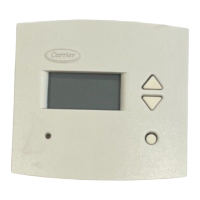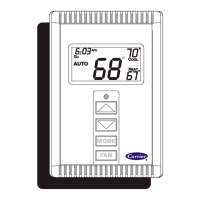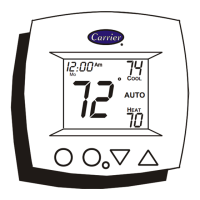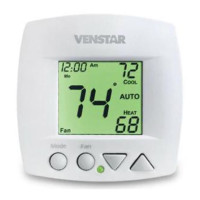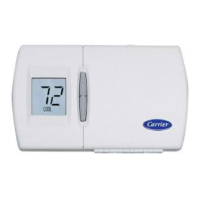Selection HumidifySetPointDisplay
NormalHumidify DehumidifySetPointValue
CooltoDehumidify DehumidifySetPointValue
DehumidifyOFF OF(Off)
Table 5--Dehumidification Selections
Mode Display Fan Display
Blank Blank
COOL Blank
Blank Blank
DEHUMIDIFICATION
Dehumidification is done only during cooling. Depending on
type of equipment used, compressor speed, blower speed, set
point adjustment, and equipment cycling are modified to provide
added dehumidification. A dehumidification set point (separate
from humidification set point) is available to the homeowner. It
can range from 50 to 90% relative humidity. When actual
humidity is higher than set point, a dehumidification demand
exists. The Thermidistat Control responds by activating its
dehumidify output. It may also control the compressor and
blower, depending on equipment type and dehumidify selection
choice. The 3 available selections are described below.
The amount of extra dehumidification available is very dependent
on the type of equipment in the home. Without a variable-speed
blower, the system's ability to adjust dehumidification is very
limited.
1. Normal Dehumidify Operation
When normal dehumidify is selected, the compressor will not
turn on without a cooling demand. If dehumidify demand exists
while cooling, dehumidify output will also be active (24vac
removed). This output commands variable-speed blowers to
reduce their airflow, which improves water removal from the
cooled air.
2. Cool to Dehumidify
The cool to dehumidify selection tells the system to operate the
compressor, within limits, when there is a dehumidify demand
even if there is no cooling demand. The limits are that the system
may overcool up to 3°. but no more. while attempting to satisfy a
dehumidify demand. Within this 3 ° range, there is an additional
balance between overcoaling and humidity satisfaction. When
overcooling must occur, the dehumidify set point is adjusted
upward by 2% per degree of overcooling. For example, a cooling
set point of 76°F and a dehumidify set point of 60% is equivalent
to a cooling set point of 75CF and a dehumidify set point of 62%.
This dehumidify set point change is internal to the Thermidistat
Control and is not shown on the display.
During cool-to-dehumidify demand, the compressor runs a
maximum of 10 minutes on, followed by 10 minutes off. When
the compressor turns off, the fan (G output) is also turned off
immediately. The immediate fan shutoff prevents re-evaporation
of water on the coil, improving dehumidification. If fan is set to
continuous, the G (fan on) signal is removed for 5 minutes
starting when compressor turns off.
In most furnaces and fan coils, the blower operates for 90 sec
after both Y and G disappear. This 90-sec delay should be
removed, if possible, for maximum dehumidification
performance. Consult furnace or fan coil Installation Instructions
to see if delay can be disabled.
3. Dehumidify Off
Dehumidification can be turned off completely. This can be done
without changing existing set points.
To Select Dehumidification (Between NORMAL, COOL TO,
and OFF)
Press HUMIDITY button to bring up humidity selections.
Successive presses will show "hu" or "dhu" in clock display.
Select "dhu"for dehumidify selections. The large display shows
actual humidity level. The smaller display (in cool set point
location) shews dehumidify set point (DSP) or OF (oft'). When
DSP value is displayed, its value can be changed with up and
down buttons. Successive presses of MODE button moves
between 3 choices above and each will be indicated as in Table 5.
Superdehumidify (With Cool to Dehumidify)
This selection only affects cool-to-dehumidify operation. It is
part of the installer setup (see Configuration Option No. 7) and
must be made by installer. The Homeowner's Guide does not
cover this selection. A requirement is the use of a variable-speed
indoor unit with super-dehumidify capability. During
cool-to-dehumidify call, it provides maximum dehumidification
by reducing airflow to a mininmm. The actual super-dehumidify
command from Thermidistat Control to the indoor unit is a Y
signal without a G signal in addition to dehumidify signal. The
indoor unit responds to this combination by reducing the airflow
to a mininmm. All other characteristics of cool to dehumidify are
the same.
Additional Dehumidify Comments
Dehumidification can he enhanced (with some efficiency loss) by
turning blower off immediately at the end of each cooling cycle
(eliminating normal 90 sec blower off delay). Where maximum
humidity removal is desired, this should be done. if possible. Fan
coils have the capability of removing this off delay, furnaces do
not. On FK or FV Fan Coils, set delay tap to 0/0. On standard fan
coils, a jumper can be cut to disable off delay. Refer to fan coil
Installation Instructions for details. If FAN is set for continuous
operation (fan ON icon displayed), G output is turned off for 5
minutes at the end of each cooling cycle as long as dehumidify
demand exists.
Like humidify, dehumidify actions are initiated when humidity is
2% above set point and are terminated when humidity drops to
2% below set point. This prevents unnecessary toggling of
dehumidify actions when humidity is near set point.
The vacation mode contains additional dehumidify features
designed to protect an unoccupied home. Refer to the "Vacation"
section for additional information.
With any dehumidify selection, if the system has a 2-speed
compressor (DIP switch No. 2 is ON) and does NOT have a
variable-speed blower (Configuration Option No. 5 set to OFF),
all cooling will be done at high speed while dehumidify demand
exists. This is because the combination of 2-speed compressor
without variable-speed blower generally has poor water removal
on low speed.
Dehumidify Output and Equipment Connections
When there is a dehumidify demand, dehumidify output is
activated, which means that a 24vac signal is removed from the
DHUM output terminal. In other words, dehumidify output logic
is reversed -- output is turned ON when no dehumidify demand
exists and is turned OFF when demand exists. This logic reversal
has come about from historical use of a standard humidistat to do
dehumidification. The humidistat contacts open on high
humidity, thus removing a 24vac signal to initiate
dehumidification. Equipment has been designed to operate in this
manner, so the Thermidistat Control must now accommodate the
existing equipment.
Carrier FK and FV Series Variable-Speed Fan Coils. all 58UHV
and 58UXV 80% Variable-Speed Furnaces, and 58MV 90%
Variable-Speed Furnaces with the DE connection have
dehumidify inputs which connect directly to Thermidistat Control
DHUM output. They are compatible with the reverse logic output
10

